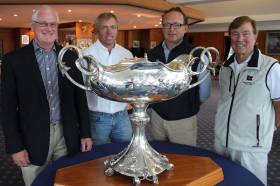Displaying items by tag: One Ton Cup
Ireland & The One Ton Cup - History Lives Again 47 Year On (Video)
In 1974, Ireland - and particularly Cork - leapt to a new level of international sailing prominence as the fresh combination of the design talents of Ron Holland, the sailmaking skills of Johnny McWilliam, and the boat-building talents of the Bushe family came together in the Crosshaven area to create a focus of ability, energy, innovation and enthusiasm which were to result in many successful craft, leading to the winning by Harold Cudmore of the Half Ton Worlds in 1976 with Silver Apple, designed by Ron Holland with sails by John McWilliam.
This theme was continued by many other achievements. But the story really started with the now-almost-mythical One Tonner Golden Apple in 1974, and Johnny McWilliam has recently unearthed an 8mm cine version of the One Ton Worlds 1974, which has been digitised by his son Jamie with the late Bob Fisher telling the tale of a time when the world was young and all things seemed - and were - possible.
Fast 40s Prepare To Honour One Ton Cup
The FAST40+ Class is the first class to have the honour of racing for the One Ton Cup since 2002. The hosting of One Ton Cup has been made possible with the agreement of the Cercle de la Voile de Paris (the "Paris Yacht Club") owner of the Cup, the support of Hamble Yacht Services, who will be the presenting partner, and the Royal Southern Yacht Club, who will be hosting the event.
W M Nixon recently referenced the origins of the Cup to the National Yacht Club in Dun Laoghaire here.
The One Ton Cup is steeped in yacht racing history, created by the Cercle de la Voile de Paris in 1899. The trophy itself was designed in 1897 by the jeweller Robert Linzeler and was made by Bratiau in 1898. It is made of solid silver and weighs 10 kgs standing at 57cm high and 81cm wide including the handles. The Coupe Internationale du Cercle de la Voile de Paris, its original name, was at the beginning raced between one-tonner dinghis sailing yachts, according to the 1892 French Godinet rule. The Cup was then raced from 1907 to 1962 on International 6 Meter. She was then adapted by the Royal Ocean Racing Club in 1965, and by the IC45 Class in 1999. The One Ton Cup has become one of the holy grails of the sport.
14 high performance FAST40+ racing yachts are expected for the One Ton Cup, flying the flags of England, Germany, Ireland, Scotland, South Africa and the United States of America. The crew, of which only five can be professionals, come from countries all over the world. Ten races are scheduled over three days, with the event rankings for each boat being multiplied by two for the overall FAST40+ 2016 Race Circuit. The courses will be a mixture of windward – leeward and round the buoys, sailed in the Solent, each lasting between 60-90 minutes. The winner will receive the One Ton Cup and be crowned FAST40+ National Champion.
“In my formative years the One Ton Cup was the cup to win. It disappeared into the mist and has now come back again. Seeing it now brings back all those memories from racing in my teenage years.” Bertie Bicket of Hamble Yacht Services and navigator on Johnny Vincent's Pace.
“It is just fantastic to have this incredibly prestigious trophy at the club. We welcome the club's association with the FAST40+ Class. Several of the owners and their families are members of the club already but we extend a very warm welcome to all of the owners and their crew for the One Ton Cup. It is promising to be a very good event and everyone at the club is really looking forward to it.” Chris Mansfield, Commodore of the Royal Southern Yacht Club.
“The One Ton Cup is essentially the biggest event of the year for the FAST40+ Class. Double points are up for grabs for the circuit, as is one of the biggest trophies in yacht racing and everyone wants to win it.” Robert Greenhalgh FAST40+ President and tactician on Sir Keith Mills Invictus.
“I have won the Quarter Ton Cup, the Half Ton Cup and have come runner up twice for the One Ton Cup, sailing on Indulgence. So yes, I would like to win it.” Peter Morton, owner & helmsman Girls on Film.
























































